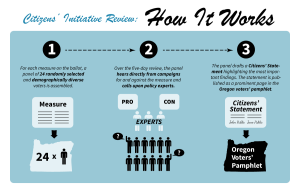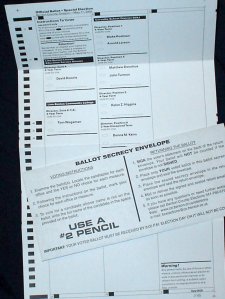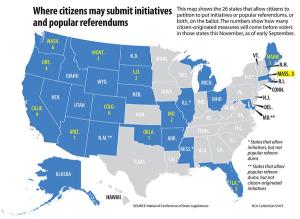Elections bring a slew of information for and against different initiatives. But how much of what you read, see and hear can be trusted? After all, who is paying for the ballot measures you are voting on? Campaign ads can often cause negative reactions from viewers. They are an expensive way to get you to change the channel. The lack of quality coupled with biased information can be frustrating at minimum and misinform you at worse.
In 2011, recognizing the lack of available quality information, the State of Oregon took a new step forward by including public participation in reviewing citizen initiatives. The non-partisan and non-profit organization Healthy Democracy Oregon came up with a plan to get its state’s citizens more involved in their voting process and provide them with a stronger voice in how their state is run.
The review is the Citizens’ Initiative Review and it provides Oregonians with an unbiased review of ballot measures done by citizens just like you. Groups of 24 randomly selected, demographically representative citizens are selected to be part of a panel for each initiative. Their job is to provide an objective review of the upcoming citizens initiatives and write a statement highlighting their most important findings. The statements are then included in the voter’s pamphlets for citizens to consider when casting their ballot.
 This use of a citizen review is no new idea, but its use with ballot measures is. Cities have used various forms of citizen advisory committees on projects for years. So why not take a page from this book and apply it to the ballot initiative system? After all who better to review and comment on citizens initiatives than the citizens themselves.
This use of a citizen review is no new idea, but its use with ballot measures is. Cities have used various forms of citizen advisory committees on projects for years. So why not take a page from this book and apply it to the ballot initiative system? After all who better to review and comment on citizens initiatives than the citizens themselves.
This week as we continue our month-long look at public participation successes, we hear from we hear from Tyrone Reitman, co-founder of Healthy Democracy Oregon. He shares with us the challenges Healthy Democracy Oregon faced when creating the Citizens’ Initiative Review, who’s on the Citizens’ Initiative Review panels and how they are selected, and how this model can improve voting in other states. We welcome his insights.
– – –
What inspired the Citizens’ Initiative Review to be established?
Oregon pioneered the ballot initiative system in 1902 to give citizens a stronger voice in their government by bypassing the legislature to create laws directly at the ballot box. After 112 years, the system is going strong but showing some signs of strain. The number of measures on ballots has increased, and so has the amount of money campaigns spend working for and against them. Ballot measure campaigns spent close to a billion dollars in 2012, as voters decided 188 questions on 39 statewide ballots (when local measures are added, the count rises above 5,000). And while legislators have access to public hearings about bills they consider, the initiative process often asks citizens to make even more impactful decisions (for instance, constitutional amendments) with little information other than what campaigns provide.
So while polls show that voters like the initiative system, they’re frustrated by a lack of quality information about measures. A supermajority of voters in several states report casting ballots on measures with which they are unfamiliar, and three in four voters say they often find the measures too complicated and confusing to understand.
As a co-founder of Healthy Democracy, you saw the Citizens Initiative Review come to fruition over the course of five years. What challenges did you face along the way?
A key challenge was to build a trustworthy process that all sides recognize as being fair and free from bias. We talked to legislators on both sides of the aisle to gain their support for this first-in-the-nation program and trained our moderators to put citizen panelists in charge of directing the reviews. We hold a very open process and panelists anonymously report their satisfaction and any perceived bias to researchers each day. Not every campaign has chosen to participate, but we’ve developed a way to bring in other advocates and ensure a fair process whether or not they participate.
How did the process get designed?
As John Gastil, Head of the Communication Arts & Sciences department at Penn State says, “The idea behind the Citizens’ Initiative Review is simple. When we give citizens a chance to deliberate and inform one another, they usually yield well-reasoned and compassionate judgments.” We started with the jury process, which has been used for centuries to bring citizens together to answer factual questions in the legal system. Ned Crosby, founder of the Jefferson Center, developed a model to use citizens’ juries to address questions of policy and governance, and has spent multiple decades refining the process. We were fortunate to have him and talented facilitators as early collaborators to help design the process.
To what extent do you think the Citizens’ Initiative Review impacts Oregon voters’ decision-making process?
We are fortunate that an independent academic research team has studied our results over the past two cycles. In 2012, for the first time, the research team found that over half of Oregon voters were aware of and used the CIR when voting, and two-thirds of them reported that it helped them make voting decisions.
 The Citizens’ Initiative Review is a randomly selected, demographically balanced panel. How are people selected?
The Citizens’ Initiative Review is a randomly selected, demographically balanced panel. How are people selected?
Initial invitations are mailed to 10,000 Oregonians selected at random from the list of registered voters, and those who agree participate are placed in a pool. For each review, 24 panelists are selected to match the demographics of Oregon’s population with regard to party affiliation, voting frequency, age, gender, ethnicity, educational attainment, and geographic location. At the end of the day our goal is to bring together a good faith reflection of the state’s voting population to deliberate, and we’ve had no trouble finding voters to do so.
How many people ultimately serve on the panel? How long do they serve?
24 panelists serve on each review, which lasts five days.
Does the panel select a chair? Is it facilitated in any way by a moderator?
The panelists meet for five days to review a ballot measure (they are compensated for their time and travel expenses). Trained moderators guide the panelists through the process of gathering initial information about the measure, selecting neutral policy experts to interview, and questioning advocates for and against the measure. The panelists deliberate and have the opportunity to ask further questions. As Maggie Koerth-Baker writes in the New York Times Magazine, “The panelists know they’re expected to base their opinions on hard evidence, and this expectation becomes part of their temporary identity. Under those conditions…facts suddenly matter.”
To conclude the Review, panelists draft a Citizens’ Statement that summarizes the most important aspects as well as how many panelists support and oppose the measure. What kind of feedback has this received from Oregon’s voters? What benefits do they express this process has for them?
An independent research team funded by the National Science Foundation and Kettering Foundation studied the reviews in 2010 and 2012 and found that in 2012, over half of voters read a CIR statement, and two-thirds found it useful when casting their ballots. In the end, voters agreed with both 2012 panels’ assessments. Media have praised the CIR for offering “the most objective analyses of the issues we’ll be voting on” (La Grande Observer). Elected leaders from both parties compliment the process for offering voters a chance to provide quality information to their fellow citizens.
Prior to the 2012 election what outreach efforts and tactics were used to generate interest and familiarity with the Review?
Oregon is a vote by mail state, and our voters’ pamphlet is widely read (over 80% of voters spend more than a half hour reading it). Since the CIR is a state program, the results are put in the Voters’ Guide, which is where most voters encounter it. We also work with media (newspapers, television, and radio) to spread the results of the reviews.
How do you plan to further let voters know about this process and its analysis?
This year we’ll be enhancing our social media work to increase our reach with younger voters who are less likely to rely on the Voters’ Guide.
 We learned that your project is the first formalized voter deliberation resource of its kind. In what other ways, if any, would you like to see Oregon’s initiative process change?
We learned that your project is the first formalized voter deliberation resource of its kind. In what other ways, if any, would you like to see Oregon’s initiative process change?
There’s a lot of frustration with the initiative process from groups on both sides of the aisle, but polls show that two-thirds of voters support the initiative system the way it is. Right now we’re focused on the CIR, and more generally, we believe that the best way to help the initiative system achieve its initial purpose of giving the people a stronger voice in their democracy is to improve voters’ access to quality, factual, unbiased information at election time.
Not all states allow citizens’ initiatives – do you see the Citizens Initiative Review as a model for other ballot measures, such as constitutional amendments?
Yes, and in fact access to quality information is especially important for constitutional amendments, which have long-lasting impacts on a state and tend to be difficult to reverse once passed. The Oregon Citizens’ Initiative Review Commission prioritizes constitutional amendments and measures with significant fiscal impacts when choosing which measures will be reviewed.
How can our voters get involved and encourage formalized voter deliberation in their home state?
Sign up for our newsletter or join our Facebook page to stay up to date on the latest in using citizen deliberation and fact-based, quality information to improve governance in America. We’re committed to providing support to groups in other states that are ready to start a Citizens’ Initiative Review, and we’ll connect you to those exciting efforts.
– – –
Healthy Democracy Oregon and the Citizens’ Initiative Review is changing voting in Oregon for the better and helping set an example for other states to follow. Tell us how you would like to see voting and ballot measures improved in your state or other citizen review processes that you know of.
Liz Faris, Account Manager
Collaborative Services, Inc.




Recent Comments